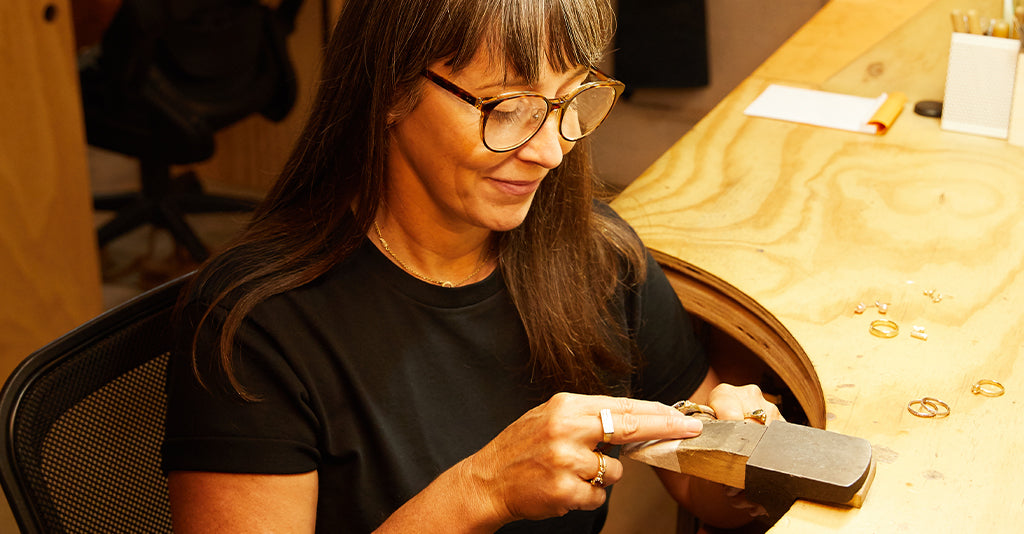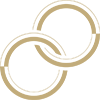Artist Focus: An Interview with Karla Way

In the second instalment of our Artist Feature series, we shine the spotlight on Melbourne based artist Karla Way, a talent we've had the pleasure of representing for the past 12 years. Interested in the various forms found in nature, Karla creates pieces employing rocky, botanical and fauna like textures and motifs to explore concepts of transformation.
Read our interview with Karla to uncover the inspirations behind her unique jewellery designs, delve into her creative design and making process, and explore the meanings behind her wearable works of art.
Can you walk us through your creative process when designing a new piece? How do you balance the natural textures and motifs you're inspired by with your own artistic vision?
In the design process, carving is primary - drawing hovers about in some sort of support mode. If drawing happens at all, it starts with a scribble, an impression; enough to capture what I’ve got in mind or the flash of an idea so I don’t lose it. I’ll then take it to the bench for some 3D ‘sketching’. As I work in the lost wax method, sketching and ideation are done in various types of jewellers waxes, predominantly in hard wax that is ideal for my preferred method of carving, cutting, building, and then something softer for the few hand-modelled elements that make it into my work.
Pieces will morph, be disassembled and reassemble, occasionally go back to the page, then back to the bench until I feel I have found the right scale and composition. As a whole, when the pieces feel balanced and cohesive, the process feels very circular. 2D drawings, if needed, are usually of the 3D model or ‘sketch’, so they become more like a record of a piece, rather than something developmental.

Hand carving in wax with tools enables creating a range of textures with subtle variations. The angle and weight of the hand; the direction and pressure of a movement produce nuanced mark-making. I’ll also work more texture into a piece after casting and like to contrast some of this with a high polish on certain spots on a piece.
I love the contrast of the clean, precise lines and high polished surface of gemstones against a rough organic faulted surface finish on a metal. The depth and warmth of yellow gold (my preferred material to work in) that has some light and shade thanks to texture, a loose line, an element of layering and the facet and gleam of a beautifully cut stone: divine.
Colour also makes its way in via the gem selection, and they often reference some other natural or atmospheric element: water, the sky, a canopy of leaves, a particular type of flower.
Everything I do is going to have a little bit of wonkiness, so praise and respect to all the gem cutters out there! I have never been good with a straight line or an identical set of two, but I very often find the balance. The right elements providing the right push and pull in space are really the things I can’t take my eyes off; that part really gives me the buzz.
Your creations often feature textures and motifs reminiscent of rocks, botanicals, and fauna. What draws you to these organic forms, and how do you translate them into wearable art?
I could stand on the street and look at a brick or sit on a coast and stare at the formations of the rocks in a headland for an age. I can get lost in the bark of a tree, the precision of the spacing of the leaves of certain species and the growth patterns in fur. The compositions and textures in nature are just mesmerising and sublime. So, I like the idea of humbly emulating some of these things or trying to elicit some sort (impossible! – but some sort) of similar response in a special piece that can be carried with you forever. It’s about appreciating the minutiae, and a reminder to stop, look around and notice the small, beautiful things – a moment of reprieve in a pretty intense world.

Do you have a particular gemstone you keep returning to, and what have you learned about this precious stone by working with it over the years?
Queensland sapphires! They are sourced from small artisanal mines or hand-fossicked by folks and then locally cut. Blends of earthy blues, yellow and greens really reflect the colours in the Australian landscape. I particularly love the blue-greens; their tones and saturation are so variable, they’re always surprising and incredibly beautiful.

Looking ahead, what themes or concepts do you hope to explore in your future collections, and how do you envision your work evolving over time?
I think I’ll be stuck on this rock for a while! I’m enjoying exploring the possibilities and variations that the lithic form and texture offer. Making time to experiment with techniques and design is so important, yet often impossible to do. However, I hope to continue learning and practicing hand skills that are either new to me or build on my existing knowledge. One of these techniques is engraving, and I aim to gain a deeper understanding through hands-on practice. Ideally, I’d like to incorporate it into the cast form, infusing finer two dimensional detail among the bold, three dimensional lithic forms – for a little more depth, and another element of contrast.




